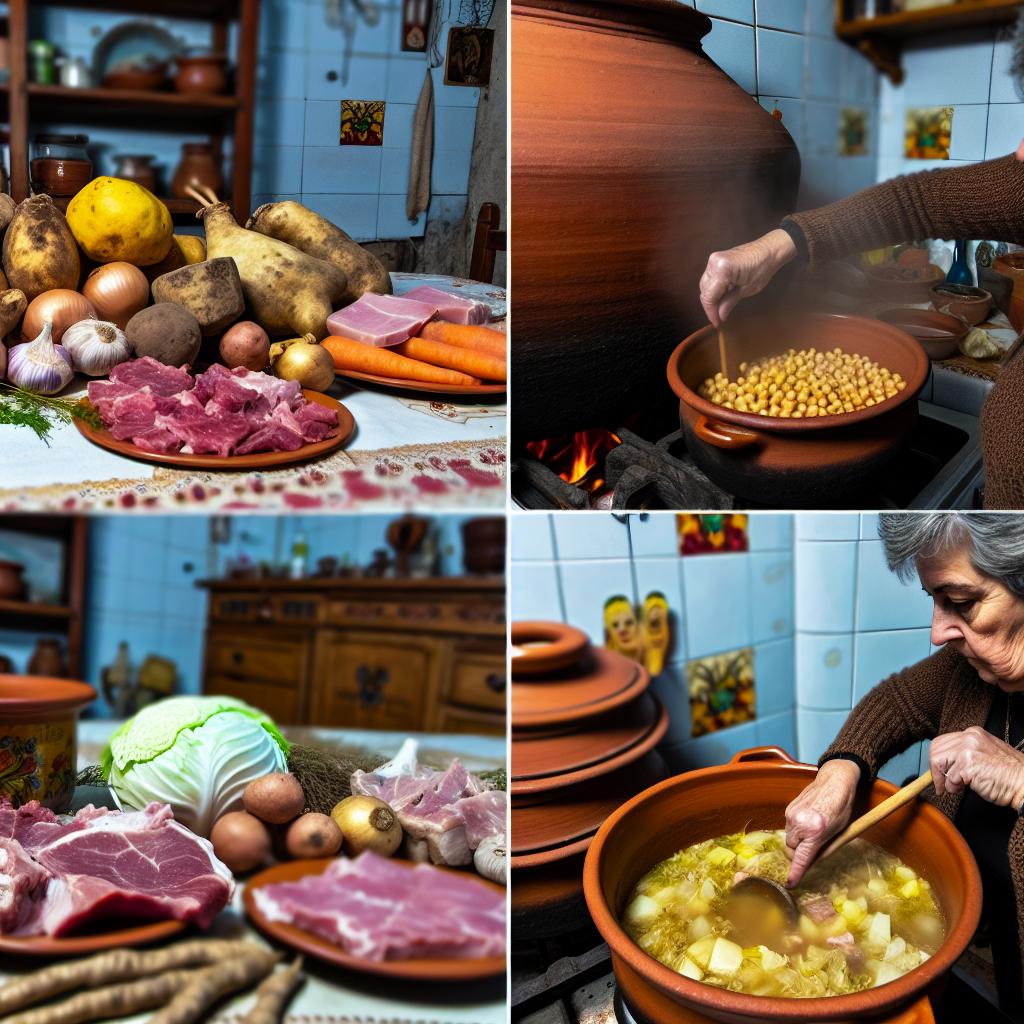
Olla podrida is a notable traditional stew that hails from the Castile region of Spain. This substantial dish is renowned for its rich and hearty flavors, embodying the essence of Spanish cuisine through the inclusion of various meats, legumes, and vegetables. The term “olla podrida” translates from Spanish to mean “rotten pot.” However, this does not imply spoilage; rather, it references the diverse and plentiful array of ingredients melded together, resulting in a complex, intense flavor profile.
Olla podrida is characterized by its unique blend of multiple ingredients, each playing a significant role in the overall composition of the stew.
Meats: The foundation of olla podrida is its use of pork, serving as the principal meat and often appearing in various forms to enhance the dish’s depth. Ham, pork ribs, and chorizo are popular additions, lending distinct flavors and textures. In some variations, beef or bacon can be included to add further complexity and richness to the stew, illustrating the versatility of the recipe.
Legumes: A key component, dried beans or chickpeas are used to add substance and texture. These legumes are instrumental in creating the stew’s body, making it a satisfying and filling dish perfect for a full-course meal.
Vegetables: To complement the meats and legumes, common vegetables such as cabbage, carrots, and potatoes are incorporated. These vegetables contribute not only to the heartiness of the stew but also add layers of flavor and nutrition, making the dish balanced and robust.
Herbs and Spices: Critical to flavoring olla podrida are the herbs and spices, which include bay leaves, saffron, and paprika. These seasonings are integral to enhancing the taste profile of the stew, imparting aromatic and savory notes that elevate the overall culinary experience.
Preparing olla podrida requires a thoughtful approach to each element, beginning with the beans or chickpeas. It is essential to soak them overnight, a step that rehydrates the legumes and prepares them for cooking. On the following day, one should drain and rinse them thoroughly to remove any residual soak water and impurities.
In a large, heavy-bottomed pot, combine these prepped legumes with the selected meats. It’s crucial to cover the combined ingredients with cold water. Bringing the pot to a gentle boil initially is necessary. As the contents heat, foam may appear on the surface, which should be skimmed off to ensure clarity and purity in the stew.
As the beans and meats begin to cook together, it’s time to add the vegetables. These should be chopped into manageable and even pieces to ensure uniform cooking and consistency in texture. After adding the vegetables to the pot, introduce the selected herbs and spices. It is important to adjust the quantities according to preference and taste, aiming for a balanced distribution of flavors throughout the pot.
With the ingredients assembled, the next crucial step in creating olla podrida is the simmering process. Cooking the stew over low heat is fundamental, extending over several hours to allow the ingredients to meld seamlessly. This slow cooking facilitates deepening of flavors, drawing out and marrying the nuances of each component into a harmonious blend.
Cooking time can vary significantly, typically ranging from 2 to 4 hours. This depends on the specific types of meats and legumes used. Throughout this period, it is advisable to occasionally inspect the stew, adjusting the seasoning with salt and pepper to taste. It may also be necessary to add water intermittently to maintain the desired consistency and prevent the stew from drying out.
Once the stew has been cooked thoroughly and all the ingredients have become tender, olla podrida is ready to be served. This dish is traditionally presented with hearty servings of crusty bread, which is perfect for absorbing the rich, flavorful broth. The combination of the stew with the bread provides a complete, satisfying meal.
Additionally, pairing olla podrida with a glass of red wine is an excellent choice, complementing the stew’s richness and adding a convivial touch to the dining experience. The robust flavors of the wine resonate nicely with the depth of the stew, enhancing the overall gustatory experience.
For those interested in expanding their culinary repertoire, exploring Spanish culinary websites can be immensely beneficial. These sites often offer a deeper insight into the regional variations and specific cooking techniques associated with olla podrida. They provide access to a range of recipes that can inspire personal adaptations, allowing cooks to experiment and adjust the dish to their preferences.
Ultimately, olla podrida stands as a testament to the richness of Spanish culinary tradition, embodying a cultural heritage that values hearty, flavorful meals. Preparing and enjoying this stew involves more than just cooking; it is an experience that connects one to the cultural roots of Spain, offering a taste of its history and traditions through its flavors and shared meals.